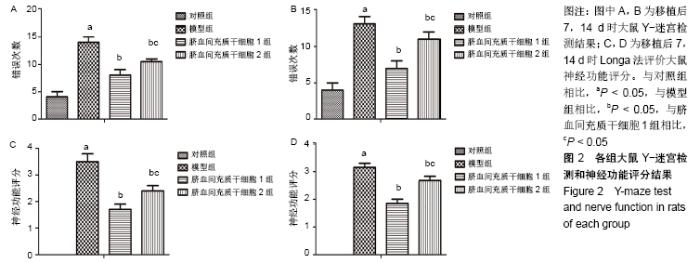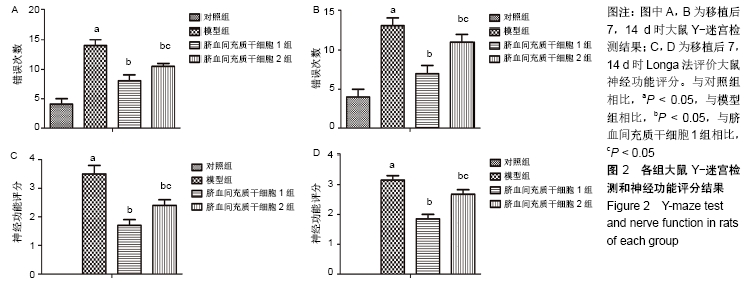[1] VANI JR, MOHAMMADI MT, FOROSHANI MS, et al. Polyhydroxylated fullerene nanoparticles attenuate brain infarction and oxidative stress in rat model of ischemic stroke. EXCLI J. 2016;15:378-390.
[2] 涂隽,温宏峰.不同脑梗死分型与脑卒中后抑郁和认知功能障碍的关系研究[J].临床和实验医学杂志,2017, 16(14):1396-1398.
[3] KAPOOR A, LANCTOT KI, BAYLEY M, 等. 身体功能恢复的脑卒中患者仍存在认知障碍、抑郁症状和重返社会障碍[J]. 中华高血压杂志,2017, 25(5):499-500.
[4] 王红阳,刘家袁,梁贵友,等.干细胞分型及其治疗缺血性心肌病机制的研究进展[J]. 山东医药,2018,58(1):95-98.
[5] Li P, Zhang YY, Deng J. PDL1Ig gene-loaded BMSCs Induce liver transplantation immune tolerance. Eur Rev Med Pharmacol Sci. 2018; 22(10):3214-3223.
[6] TIAN ZK, LIU L, CHEN DL, et al. Effect of miR-21 in promoting angiogenesis differentiation of umbilical cord blood mesenchymal stem cells in vitro. Shanghai Kou Qiang Yi Xue. 2017;26(5):471-475.
[7] 韩小改,李建斌,单泓,等.两种状态脐血间充质干细胞移植对脑梗死大鼠神经功能恢复的对比研究[J].中国组织工程研究, 2018, 22(9):1395-1401.
[8] 侯亮,徐芳,刘学春,等.人脐带血间充质干细胞移植对脑梗死大鼠外周血 Foxp3表达的影响[J].中风与神经疾病杂志, 2016,33(12):1060-1063.
[9] OUSMAN SS, FREDERICK A, LIM EF. Chaperone Proteins in the Central Nervous System and Peripheral Nervous System after Nerve Injury. Front Neurosci. 2017;11:79.
[10] XIONG Y, MAHMOOD A, CHOPP M. Emerging potential of exosomes for treatment of traumatic brain injury. Neural Regen Res. 2017;12(1): 19-22.
[11] 张君,李娜,刘俊骞,等.人脐带血间充质干细胞和神经干细胞移植对帕金森模型大鼠神经营养作用的比较[J].解剖学杂志, 2017,40(6):692-697.
[12] 易娟,李贵南.神经干细胞移植治疗新生儿脑损伤的前景展望[J].中国新生儿科杂志, 2017, 32(5):398-400.
[13] 王丽敏,谭振香,霍明霞,等.人脐血间充质干细胞移植联合mNGF治疗脑瘫大鼠的实验研究[J].中国儿童保健杂志, 2017,25(1):32-36.
[14] 陈刚.丹红注射液对脑梗死大鼠神经行为学改变、细胞损伤及凋亡的影响[J].海南医学院学报, 2017, 23(6):724-727.
[15] DEY JH, BIANCHI F, VOSHOL J, et al. Targeting fibroblast growth factor receptors blocks PI3K/AKT signaling, induces apoptosis, and impairs mammary tumor outgrowth and metastasis. Cancer Res. 2010;70(10):4151-4162.
[16] BAHARARA J, RAMEZANI T, DIVSALAR A, et al. Induction of Apoptosis by Green Synthesized Gold Nanoparticles Through Activation of Caspase-3 and 9 in Human Cervical Cancer Cells. Avicenna J Med Biotechnol. 2016;8(2):75-83.
[17] PU X, STORR SJ, ZHANG Y, et al. Caspase-3 and caspase-8 expression in breast cancer: caspase-3 is associated with survival. Apoptosis. 2017;22(3):357-368.
[18] 赵锦慧,周琳.钠离子对洋葱细胞程序性死亡的诱导[J]. 江苏农业科学, 2016, 44(11):189-191.
[19] 贾晓鹏,孙亚楠,王伟,等.二十二碳六烯酸诱导前列腺癌细胞凋亡的信号通路研究[J].中华实验外科杂志,2017, 34(10):1667-1670.
[20] GE Y, CAI YM, BONNEAU L, et al. Inhibition of cathepsin B by caspase-3 inhibitors blocks programmed cell death in Arabidopsis. Cell Death Differ. 2016;23(9):1493-1501.
[21] 宋天玲,孟旭霞,曹博雯,等.尾静脉注射人脐带间充质干细胞对早期糖尿病大鼠视网膜神经细胞凋亡及胶质纤维酸性蛋白表达的影响[J].中华眼底病杂志, 2018, 34(2):164-167.
[22] 黄晓慧,张双立,向文强,等.人脐血间充质干细胞通过TERT与脑缺血相关的研究进展[J].卒中与神经疾病,2018, 25(5):113-115,122.
[23] 郭雪花,刘宁.端粒酶逆转录酶的新生物学功能[J].中国生物化学与分子生物学报, 2018, 34(9):927-934.
[24] 刘一民,赵艳艳,陈红兵.神经干细胞移植脑缺血模型大鼠神经细胞凋亡、分化及神经行为学的变化[J].中国组织工程研究,2017,21(13): 2029-2035.
[25] 马巧亚,何娅,王锐利,等.丁苯酞软胶囊对急性脑梗死患者ROS、T-AOC、炎症因子及神经功能的影响[J].现代生物医学进展, 2018,18(12): 2306-2310.
[26] SHEN J, RASTOGI R, GENG X, et al. Nicotinamide adenine dinucleotide phosphate oxidase activation and neuronal death after ischemic stroke. Neural Regen Res. 2019;14(6):948-953.
[27] 陈刚.丹红注射液对脑梗死大鼠神经行为学改变、细胞损伤及凋亡的影响[J].海南医学院学报,2017,23(6):724-727.
|











